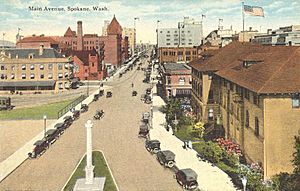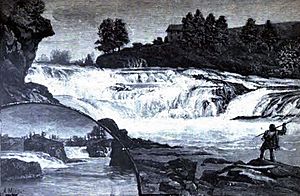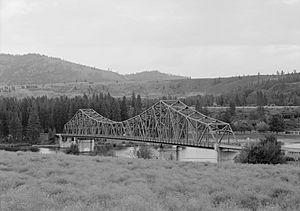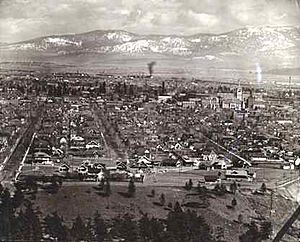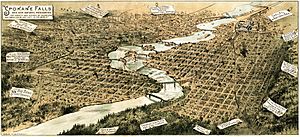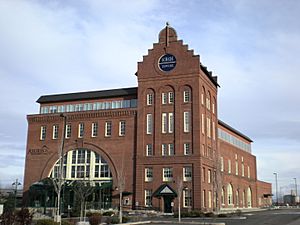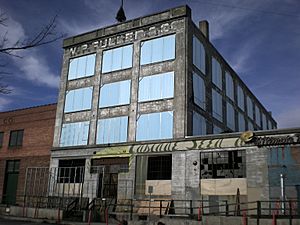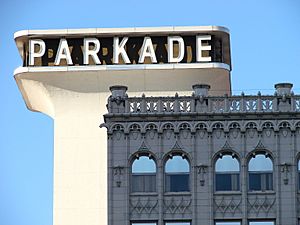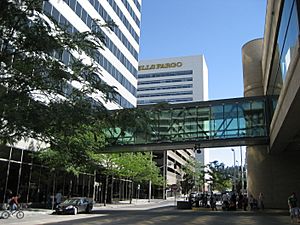History of Spokane, Washington facts for kids
The history of Spokane, Washington in the northwestern United States developed because Spokane Falls and its surroundings were a gathering place for numerous cultures for thousands of years. The area's indigenous people settled there due to the fertile hunting grounds and abundance of salmon in the Spokane River. The first European to explore the Inland Northwest was Canadian explorer-geographer David Thompson, working as head of the North West Company's Columbia Department. At the nexus of the Little Spokane and the Spokane, Thompson's men built a new fur trading post, which is the first long-term European settlement in Washington state.
The first American settlers, squatters J.J. Downing, with his wife, stepdaughter, and S.R. Scranton, built a cabin and established a claim at Spokane Falls in 1871. James N. Glover and Jasper Matheney, two Oregonians passing through the region in 1873, recognized the value of the Spokane River and its falls. They realized the development potential and bought the claims of 160 acres (0.65 km2) and the sawmill from Downing and Scranton for $4,000 total. Glover and Matheney knew that the Northern Pacific Railroad Company had received a government charter to build a main line across this northern route. By 1881, the Northern Pacific Railway was completed, bringing major European settlement to the area. With the arrival of the Northern Pacific Railroad and the later additions to the city's railroad infrastructure by the arrival of the Union Pacific, Great Northern, and Chicago, Milwaukee, St. Paul and Pacific railroads, Spokane became the commercial center of the Inland Northwest. It was one of the most important rail centers in the western United States. Spokane hosted the first environmentally themed World's Fair in Expo '74, becoming the then-smallest city to ever host a World's Fair. With falling silver, timber, and farm prices, the city economy began a decline that would last into the 1990s. Spokane is still trying to make the transition to a more service-oriented economy. The opening of the River Park Square Mall in 1999 sparked a downtown rebirth that included the building of the Spokane Arena and expansion of the Spokane Convention Center.
Pre-contact to 1810
First habitation
The Spokane Falls and its surroundings were a gathering place and focus for settlement for the area's indigenous people for thousands of years, due to the fertile hunting grounds and abundance of salmon in the Spokane River. The first humans to arrive in the Spokane area arrived between 12,000 and 8,000 years ago and were hunter-gatherer societies who lived off the plentiful game in the area. Initially, the settlers hunted predominantly bison and antelope, but after the game migrated out of the region, the native people became dependent on gathering various roots, berries, and nuts, and harvesting fish. The Spokane tribe, after which the city is named (which means "Children of the Sun" or "sun people" in Salishan), are believed to be either direct descendants of the original hunter-gatherers who settled in the region, or descendants of tribes that migrated to the area from the Great Plains. When asked about their origins by early white explorers, the tribe said their ancestors came from "Up North".
The Spokane Falls were the tribe's center of trade and fishing. The Spokane consisted of three bands that lived along the Spokane River. The Spokane people shared their culture and Salishan language with several other tribes, including the Coeur d' Alenes, Kalispels, Pend Oreilles, Flatheads, Kootenays, and Colvilles among others.
Early in the 19th century, the Northwest Fur Company sent two white fur trappers west of the Rocky Mountains to search for fur. They were friendly with the native people they encountered. The trappers became the first two white men met by the Spokane tribe, who believed them to be Sama, or sacred. They helped them get shelter in the Colville River valley for the winter. The tribe discovered the men brought no "big magic" to the tribe, as their members had continued to die from smallpox, which had first struck the tribe in an epidemic in 1782. As much as half the tribe had died in that epidemic.
1810–1890
Trading post
The explorer-geographer David Thompson, working as head of the North West Company's Columbia Department, became the first European to explore the Inland Empire (now often called the Inland Northwest). Crossing what is now the U.S.–Canada border from British Columbia, Thompson wanted to expand the North West Company further south in search of furs. After establishing the Kullyspell House and Saleesh House trading posts in what are now Idaho and Montana, Thompson then attempted to expand further west. He sent out two trappers, Jacques Raphael Finlay and Finan McDonald, to construct a fur trading post on the Spokane River in Washington and trade with the local Indians. This post was established in 1810, at the confluence of the Little Spokane and Spokane rivers, becoming the first enduring European settlement of significance in Washington state. Known as the Spokane House, or simply "Spokane", it was in operation from 1810 to 1826. Operations were run by the British North West Company and later the Hudson's Bay Company, and the post was the headquarters of the fur trade between the Rocky and Cascade mountains for 16 years. After the latter business absorbed the North West Company in 1821, the major operations at the Spokane House were eventually shifted north to Fort Colvile, reducing the post's significance.
In 1836, Reverend Samuel Parker visited the area and reported that around 800 Native Americans were living in Spokane Falls. A medical mission was established by Marcus and Narcissa Whitman to cater for Cayuse Indians and hikers of the Oregon Trail at Walla Walla in the south. After the Whitmans were killed by Indians in 1847, Reverend Cushing Eells established Whitman College in the city of city of Walla Walla, Washington in their memory. Rev. Eells built the first church in Spokane in 1881. Between 1881 and 1882 the first Baptist and Episcopal churches were started, and the first Presbyterian church in 1883.
In 1853, two years after the establishment of the State of Washington, the first governor, Isaac Stevens, made an initial effort to make a treaty with Chief Garry and the Spokanes at Antoine Plantes’ Ferry, not far from Millwood.
An increasing American settler presence in Washington Territory caused simmering tensions and conflicts between the Native American tribes and white settlers, many miners en route to seek fortune in the gold fields in the Colville district. These conflicts and reprisals eventually prompted intervention from the United States Army on October 5, 1855, starting the Yakima Indian War. The last campaign of this war, the Coeur d'Alene War, was brought to a close by the actions of Col. George Wright, who won decisive victories against a confederation of tribes in engagements at the Battle of Four Lakes and the Battle of Spokane Plains, avenging an earlier loss under Lt. Col. Edward Steptoe at the Battle of Pine Creek. Wright’s actions ended the hostilities and opened the mountain valley of the Pacific Northwest to safe habitation by settlers.
American settlement
Joint American–British occupation of Oregon Country, in effect since the Treaty of 1818, eventually led to the Oregon Boundary Dispute after a large influx of American settlers along the Oregon Trail. The first American settlers in what is now Spokane were J.J. Downing and S.R. Scranton, cattle ranchers who squatted and established a claim at Spokane Falls in 1871. Together they built a small sawmill on a claim near the south bank of the falls. James N. Glover and Jasper Matheney, Oregonians passing through the region in 1873, recognized the value of the Spokane River and its falls for the purpose of water power. They realized the investment potential and bought the claims of 160 acres (0.65 km2) and the sawmill from Downing and Scranton for a total of $4,000. Glover and Matheney knew that the Northern Pacific Railroad Company had received a government charter to build a main line across this northern route. Amid many delays in construction and uncertainty over the completion of the railroad and its exact course, Matheney sold his interest in the claim to Glover. Glover confidently held on to his claim and became a successful Spokane business owner and mayor. He later came to be known as the "Father of Spokane".
Fort Spokane
In 1880, Fort Spokane was established by U.S. Army troops under Lt. Col. Henry Clay Merriam 56 miles (90 km) northwest of Spokane, at the junction of the Columbia and Spokane Rivers, to protect the construction of the Northern Pacific Railway and secure a place for U.S. settlement. Settlers among the Spokane and Colville Indians in Eastern Washington were afraid that war might break out. Camp Spokane served to separate the Indians from the settlers, being located between the Colville and Spokane reservations—protecting the growing non-Indian communities of Spokane Falls (later Spokane) and Cheney. While stationed, Merriam's troops erected some temporary buildings at the post, which they initially called Camp Spokane, but in 1881 one of the four infantry companies was still living in tents. Then early in 1882, President Arthur formally set aside a military reservation at the site, which was renamed Fort Spokane.
Northern Pacific Railway
By June 30, 1881, the railway reached the city, bringing major European settlement to the area. The city of Spokan Falls (the "e" was added in 1883 and "Falls" dropped in 1891) was officially incorporated as a city of about 1,000 residents on November 29, 1881. When Spokane was officially incorporated in 1881 Robert W. Forrest was elected as the first mayor of the city, with a Council of seven-S.G. Havermale, A.M. Cannon, Dr. L.H.Whitehouse, L.W. Rima, F.R. Moore, George A. Davis, and W.C. Gray, all serving without pay. Glover became the founder and "Father of Spokane" as well as its second mayor. The small population increased rapidly, streets were built, and the small settlement became a city. The city's population grew from 4,130 to 8,891 between 1881 and 1885 and wrested the county seat from Cheney in the 1886 elections. The city's population ballooned to 19,922 in 1890, and 36,848 in 1900 with the arrival of the additional railroads. The railroads lured settlers from as far away as Finland, Germany, and England and as close as Minnesota and the Dakotas. The marketing campaigns of transportation companies with affordable fertile land to sell along their trade routes lured many settlers into the region they dubbed "Spokane Country". By 1910, the population hit 104,000; the building of the Northern Pacific, allowed Spokane to eclipse Walla Walla as the commercial center of the Inland Northwest. In time the city came to be known as the "capital" of the Inland Empire and the heart of a vast tributary region.
The Great Fire
Spokane's growth continued unabated until August 4, 1889, when a fire, now known as The Great Fire (not to be confused with the Great Fire of 1910, which happened nearby), began just after 6:00 p.m. and destroyed the city's downtown commercial district. Due to technical problems with a pump station, there was no water pressure in the city when the fire started. In a desperate bid to starve the fire, firefighters began razing buildings with dynamite. Eventually the winds and the fire died down; 32 blocks of Spokane's downtown core had been destroyed and one person killed.
Dutch investment
The financing for rebuilding the downtown core came in large part from the infusion of investment from Dutch bankers. Real Estate development by European investors was a major source of capital for the rebuilding of Spokane. In 1883, Herman A. Van Valkenburg, a Dutch businessman, came to Spokane to appraise railroad investments, and in 1885, formed the Northwestern and Pacific Mortgage Company. The company was reorganized in The Netherlands as the Northwestern and Pacific Hypotheekbank on June 4, 1889. The company rebuilt the buildings in downtown with granite and brick to replace wooden buildings that had been destroyed. By 1893, Dutch investors held one-fourth of real estate in Spokane, and continued to provide a significant contribution to Spokane's growth through the middle of the 20th century. Following the depression of 1893, many of these Dutch bankers sold their ventures to new local investors.
1890–1980
The Great Northern Railway

Despite the catastrophe and devastation of the fire, Spokane experienced a building boom. After The Great Fire of 1889, the downtown was rebuilt and the city was reincorporated under the present name of "Spokane" in 1891. According to historian David H. Stratton, "From the late 1890s to about 1912, a great flurry of construction created a modern urban profile of office buildings, banks, department stores, hotels and other commercial institutions," which stretched from the Spokane River to the site of the Northern Pacific railroad tracks below the South Hill. Yet the rebuilding and development of the city was far from smooth: between 1889 and 1896 alone, all six bridges over the Spokane River were destroyed by floods before their completion.
Just three years after the fire, in 1892, James J. Hill's Great Northern Railway had arrived in the newly created township of Hillyard (annexed by Spokane in 1924)—the chosen site for Hill's rail yards, machine shops, and roundhouse because of the area's flat ground. The addition of Hill's railroad resulted in another small population boom. Much of the town was built to house railroad workers, mainly immigrant laborers working in the local yard. The city also had developed a sizable Asian community, mostly Japanese, centered in a district called Chinatown. As in many western railway towns, the Asian community started off as an encampment for migrant laborers working on the railroads. These railroads in Spokane made it a transportation hub for the Inland Northwest region.
Spokane as a commercial center
With the arrival of the Northern Pacific Railroad and the later additions to the city's railroad infrastructure, Spokane became the commercial center of the Inland Northwest. Spokane became an important rail and shipping center because of its location between the Rocky Mountains and the Cascade Range and between mining (particularly Idaho's Silver Valley and agricultural areas. After the arrival of the Northern Pacific, the Union Pacific, Great Northern, and Chicago, Milwaukee, St. Paul and Pacific railroads, Spokane became one of the most important rail centers in the western United States, being the site of four transcontinental railroads.
Mining
In 1883 discovery of gold, silver, and lead in the Coeur d'Alene region. Mining emerged as a major stimulus to Spokane and the city served as a popular outfitting and jumping off point for miners. The discovery of gold, silver, and lead in the Coeur d'Alene region (which generally encompasses present day Stevens, Ferry, and Pend Oreille counties and northern Idaho) in the 1880s precipitated a rush of prospectors into the region. The Inland Empire erupted with numerous mining rushes from 1883 to the late 19th century. In the 1890s the city was subject to intrastate migration by African-Americans from Roslyn, looking for work after the closure of the area's mines. Two African-American churches, Calvary Baptist and Bethel African Methodist Episcopal, were founded in 1890.
Spokane became home to many entrepreneurs, companies and managers as well as the place to finance mining and other business operations. As a regional shipping center, the city furnished supplies to the miners who passed through on their way to mine in the Coeur d’Alene region. At the onset of the initial 1883 gold rush near Coeur d'Alene, Spokane became the outfitter of choice among prospectors due to the areas lower prices and convenience of being able to obtain everything "from a horse to a frying pan". It would keep this status for subsequent rushes in the region due to its trade center status and accessibility to railroad infrastructure. During the mining boom, Spokane had its own stock exchange, the Spokane Stock Exchange, which began trading mining shares on January 18, 1897. The exchange originally consisted of 32 members and listed 37 stocks of mines across northeastern Washington, northern Idaho and southern British Columbia. Today, the Spokane area is still considered one of the most productive mining districts in North America.
Emergence of logging, forestry, and agribusiness
After mining declined at the turn of the 20th century, agriculture and logging became the primary influences in the Spokane economy. The lumber industry in Spokane began with the city's founding in 1871 when Downing and Scranton built Spokane's first business, a sawmill. As with the mining industry, the lumber industry in the city contributed to the economy by the means of outfitting the lumberjacks and millmen working in the hundreds of mills along the railroads, rivers, and lakes of northern Washington and Idaho. The population explosion and the building of homes, railroads, and mines in northern Idaho and southern British Columbia fueled the industry. Before the construction of the railroads that connected the region, Spokane’s lumber supply was largely imported from North Idaho, especially St. Maries, Idaho; lumber would be rafted 25 miles north on the St. Joe River and Lake Coeur d'Alene and then rafted down to Spokane’s mills via the Spokane River. Although overshadowed in importance by the vast timbered areas on the coastal regions west of the Cascades, and burdened with monopolistic rail freight rates and stiff competition, Spokane became a noted leader in the manufacture of doors, window sashes, blinds, and other planing mill products.
During this period, railroad companies charged what many believed were unfair shipping rates on goods going into Spokane. These rates were much higher than rates to coastal seaport cities such as Seattle and Portland; so much so that Minneapolis merchants could ship goods first to Seattle and then back to Spokane for less than shipping directly to Spokane, even though the rail line ran through Spokane on the way to the coast. This had a significant impact on the local economy, with many merchants simply choosing not to do business in Spokane. In 1892, the Interstate Commerce Commission agreed with the city after it filed a complaint about these practices, but that decision was struck down by a federal court. In 1906, Spokane sued under the newly passed Hepburn Act, and won on July 24, 1911. Due to these shipping rates, no alternative transport for their shipments, the lack of a seaport, and access to international markets, Spokane never became a prominent leader in the production of lumber.
The city became noted for processing and distributing dairy and orchard products and for producing products milled from timber. The Spokane area is a major center for the timber and agriculture in the Inland Northwest region. By the early twentieth century Spokane was primarily a commercial center rather than an industrial center.
Growth and stagnation
Spokane continued to grow rapidly through the early 20th century. By 1900, the population had reached 36,848, and by 1910 had more than tripled, to 104,402. The expansion and growth of Spokane abruptly stopped in the 1910s and was followed by a period of population decline. This growth pattern continued until 1917, when the population reached 150,323. Spokane's slowing economy largely contributed to this decline. Control of regional mines and resources became increasingly dominated by national corporations rather than locals, diverting capital outside of Spokane and decreasing growth and investment opportunities in the city. At the turn of the 20th century, much of the Inland Empire's mining districts were sold to outside interests due to the regions' insufficient capital to fully exploit the mines potential. Local morale was also affected for years by the collapse of the Division Street Bridge early in the morning on December 15, 1915, which killed five people and injured over 20, but a new bridge was built (eventually replaced in 1994).
The 1920 census showed a net increase of just 35 individuals, which actually indicates that thousands left the city when considering the natural growth rate of a population. The 1920s and 1930s saw the similar, but less drastic slow growth of the 1910s, and this change of outlook forced city boosters to market the city as a quiet, comfortable place suitable for raising a family rather than a dynamic community full of opportunity. The Inland Northwest region was heavily dependent on extractive products produced from farms, forests, and mines which experienced a fall in demand. Spokane's situation improved with the start of World War II when aluminum production initiated in the Spokane valley due to the areas inexpensive electricity and the increased demand for airplanes.
Free speech fight
During this time of stagnation, unrest was prevalent among the area's unemployed, who became victimized by "job sharks", who charged a fee for signing up workers in the logging camps. Job sharks and employment agencies were known to cheat itinerant workers, sometimes paying bribes to periodically fire entire work crews, thus generating repetitive fees for themselves. Crime spiked in the 1890s and 1900s, with eruptions of violent activity involving unions such as the Industrial Workers of the World (IWW), or "Wobblies" as they were often known, whose free speech fights had begun to garner national attention. Now, with grievances concerning the unethical practices of the employment agencies, they initiated a free speech fight in September 1908 by purposely breaking a city ordinance on soapboxing. With IWW encouragement, union members from many western states came to Spokane to take part in what had become a publicity stunt. Many Wobblies were incarcerated, including feminist labor leader Elizabeth Gurley Flynn, who published her account in the local Industrial Worker.
First celebration of Father's Day
Spokane is known as the birthplace of the national movement started by Sonora Smart Dodd that led to the proposal and eventual establishment of Father's Day as a national holiday in the U.S. The first observation of Father's Day in Spokane was on June 19, 1910. Sonora conceived the idea in Spokane's Central Methodist Episcopal Church while listening to a Mother's Day sermon.
1960s and 1970s: Revitalization efforts
After decades of slow growth, Spokane businessmen headed by King Cole formed Spokane Unlimited, an organization that sought to revitalize downtown Spokane. Early but modest success came in the form of a new parking garage in 1965, The Parkade. Soon, focus to revitalize the economy focused on improving Havermale Island, which was dominated by railroad depots and warehouses. A recreation park that would showcase the Spokane falls was the preferred option, and the organization successfully negotiated freeing up the island property and relocating the rail lines. In the early 1970s, Spokane was approaching its one-hundredth birthday, and Spokane Unlimited hired a private firm to start preparations for a celebration and fair. In a report delivered by the firm, the proposal of a world's fair was introduced, which culminated in Expo '74.
1974 World's Fair
Spokane hosted the first environmentally themed World's Fair in Expo '74, becoming the then-smallest city to ever host a World's Fair. Expo '74 also had the distinction of being the first American fair after World War II to be attended by the Soviet Union. This event transformed Spokane's downtown, removing a century of railroad industry that built the city and reinventing the urban core. The Spokane clock tower was once part of a Great Northern Railway depot that once occupied the site. Upon close inspection, it can be seen where bricks were added on and where the roof used to be. The clock tower is one of the biggest in the Northwest, with each of its clock faces measuring 9 feet (2.7 m) across.
Many of the structures built for the World's Fair are still standing and in use. The United States Pavilion sits next to an IMAX theater, and the Washington State Pavilion became the INB Performing Arts Center. The Expo site itself, located on Havermale Island, became the 100-acre (0.40 km2) Riverfront Park, containing, among other features, the U.S. Pavilion, the turn-of-the-20th-century Riverfront Park Looff Carousel, and the Great Northern Railway clock tower, the last remnant of the rail depot that was demolished for Expo '74. The U.S. Pavilion and the clock tower are prominently featured in the park's logo. At this time, the Chinatown district was slated for demolition as well. The Chinatown Asian community thrived until the 1940s, after which its population decreased and became integrated and dispersed, losing its Asian character; urban blight and the preparations leading up to Expo '74 led to Chinatown's eventual demolition.
The late 1970s was a period of growth for Spokane which led to the construction in the early 1980s of the two tallest buildings in the city, the 18-story Farm Credit Banks Building and the 20-story Seafirst Financial Center, now the Bank of America building.
1980s: Recession and diversification
The success seen in the late 1970s and early 1980s once again was interrupted by another U.S. recession in which silver, timber, and farm prices dropped. The period of decline for the city lasted into the 1990s and was also marked by a loss of many steady family-wage jobs in the manufacturing sector. Although a tough period, Spokane's economy had begun to benefit from economic diversification, being the home to growing companies such as Key Tronic and having research, marketing, and assembly plants for other technology companies helped lessen Spokane's dependency on natural resources.
21st century
Spokane is still trying to make the transition to a more service-oriented economy in the face of a less prominent manufacturing sector. Developing the city's strength in the medical and health sciences fields has seen some success, resulting in the expansion of the University District with a University of Washington and Washington State University medical school branches. The city faces challenges such as a scarcity of high-paying jobs, pockets of poverty, and areas of high crime.
The opening of the River Park Square Mall in 1999 sparked a downtown rebirth that included the building of the Spokane Arena and expansion of the Spokane Convention Center. Other major projects include the building of the Big Easy concert house (now the Knitting Factory) and renovation of the historic Montvale Hotel, the Kirtland Cutter-designed Davenport Hotel (after being vacant for over 20 years), and the Fox Theater (now home to the Spokane Symphony) as well as the completion of the WSU Pharmaceutical and Biomedical Sciences Building in 2013 and the Davenport Grand Hotel in 2015 and the ongoing renovation of Riverfront Park. The Kendall Yards development on the west side of downtown Spokane is one of the largest construction projects in the city's history. Directly across the Spokane River from downtown, it will blend residential and retail space with plazas and walking trails.
Images for kids
-
The fertile rolling hills of the Palouse viewed from Steptoe Butte
-
Looking north. Shows IXL Clothing Co. at 425-7 Riverside Ave., and Old National Bank at Riverside Ave., northeast corner of Stevens in 1914.


